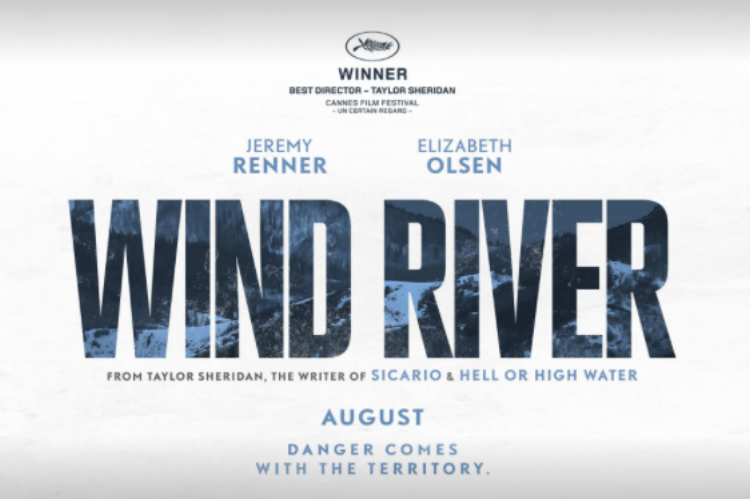Taylor Sheridan is on a roll. Fresh from writing back-to-back stellar films, Sicario and Hell or High Water, Sheridan gives us another gem with Wind River. Jeremy Renner and Elizabeth Olsen respectively star in Wind River as a U.S. Fish and Wildlife tracker and an FBI agent. They are tasked with tracking a murderer in this meditative thriller set on the frozen landscape of Wyoming.
Sheridan’s films always contain more than is first presented on the surface. In Sicario we were given grim analysis of the current state of the U.S. War on Drugs grafted onto a tense mystery thriller. Yet Sheridan still found time to examine the backdrop of family life in Mexico under the shadow of a Cartel. In Hell or High Water, Sheridan brilliantly excoriated the financial predators that lead America to the financial crisis of 2007, while executing an exciting, distinctly Texan, heist movie. For good measure, Sheridan even threw in further rumination on the very nature of such predators as it relates to the legacy of Native Americans. Sheridan’s films may be a little pretentious but he manages to convey subtext without having to bludgeon audiences with his messaging.
In Wind River, Sheridan continues his examination of Native Americans but shifts the entire focus to their tragic legacy. Sheridan himself has said that Wind River is based on the thousands of assaults on Native American women (1). Sheridan asserts that the modern reservation system perpetuates and even enables these assaults to happen. These reservations are rank, poverty-stricken places with little hope. Drugs, alcohol, and grief ravage the reservation. Most of the characters on the reservation, in Sheridan’s depiction, wallow in palpable sorrow and depression. In fact, many of the poorest places in the United States are Native American reservations. Our lead, Corey Lambert (Jeremy Renner), the U.S. Fish and Wildlife tracker, muses solemnly, “These people were forced here, stuck here for a century. This snow and silence, it's the only thing that hasn't been taken from them.” Our other lead, Jane Banner (Elizabeth Olsen), plays the audience surrogate, an FBI agent in way over her head shocked by life in Wind River. Sheridan drops a powerful and somber bomb at the end of the film in the form of an epilogue text, reminiscent Spotlight’s closing, informing the viewer that missing person statistics are kept on every ethnic group except Native American women.
Sheridan’s direction is one of the few weaknesses of the film, and, really, is not even that bad. The film showcases beautiful shots of the wide open, frozen plains of Wyoming, which are directly juxtaposed with the poverty-stricken, desolate Wind River Reservation. The biggest problem I have with Sheridan’s direction is that the pacing is off. The film is a slow burn and reflects on survivors’ grief while Renner and Olsen track the killer of a Native American woman. Unfortunately, the tracking of the killer has little buildup and there isn’t much mystery or many suspects. Sheridan keeps the viewer in the dark while Renner tracks the culprits and finds them without much trouble. The mystery itself is resolved with a flashback right before the bloody, brutal, and satisfying climax.
In addition, Renner’s character is a textbook definition of a white savior, who tracks and finds killers on reservation land for these ill-fated Native Americans. Jason Asenap, a Native American writer, asserts in his article, “Why do white writers keep making films about Indian Country?,” that while Sheridan’s politics are on the right side of history and he uses his power in Hollywood to highlight an important issue, he nevertheless continues the long Hollywood tradition of portraying Native Americans through a non-native white savior lens (2). He posits,
....In Hollywood, the Indians die. To this day, the Indians die, and not just physically, but culturally. Simpson and Sheridan are invested in making us see how America has screwed Native people, but to the point of rubbing it in our faces. Is it so terrible to live in one’s own homeland? It may be hard to get out, but it certainly feels condescending for a non-Native to write as much….Is it so bad to be Indigenous in the 21st century? Does a positive message redeem poor narrative? Does giving a good cause free you from obligations to the culture you are telling stories about? And finally: When do the Indians win? (2)
Thankfully the film’s shortcomings are made up for by Sheridan’s writing. He is, unfortunately following two extremely stellar films so this one just pales slightly in comparison.
Sheridan’s Wind River is a reflective tale about grief, the cyclical nature of violence, and sexual assault enabled by the Native American Reservation system. Sheridan has considerable writing skill and it is good that he continues to create. Despite being patronizing to its Native viewers by relying on the white savior trope, I believe the film’s heart is in the right place (2). Like Sheridan or Dee Brown and a multitude of other authors, I should add that I too have a fascination with Native American history and culture, so I do appreciate the focus Sheridan brings to such a tragic issue that is often completely overlooked. While his directing chops might need some work, this doesn’t distract from the overall quality of the film. Wind River hits all the right notes, and its head over heals better than frozen thrill, The Snowman.
TLDR: Wind River is a thoughtful crime thriller and another well-written tale from Taylor Sheridan. It falls just short of his previous outings but is still a welcome addition. 4/5 Stars
Bibliography:
1. Asenap, Jason. “Why Do White Writers Keep Making Films about Indian Country?” www.hcn.org, High Country News, 15 Sept. 2017, www.hcn.org/issues/49.18/tribes-why-do-white-writers-keep-making-films-about-indian-country.
2. “Investigating A Murder In 'Wind River'.” NPR, NPR, 5 Aug. 2017, www.npr.org/2017/08/05/541774348/investigating-a-murder-in-wind-river.


